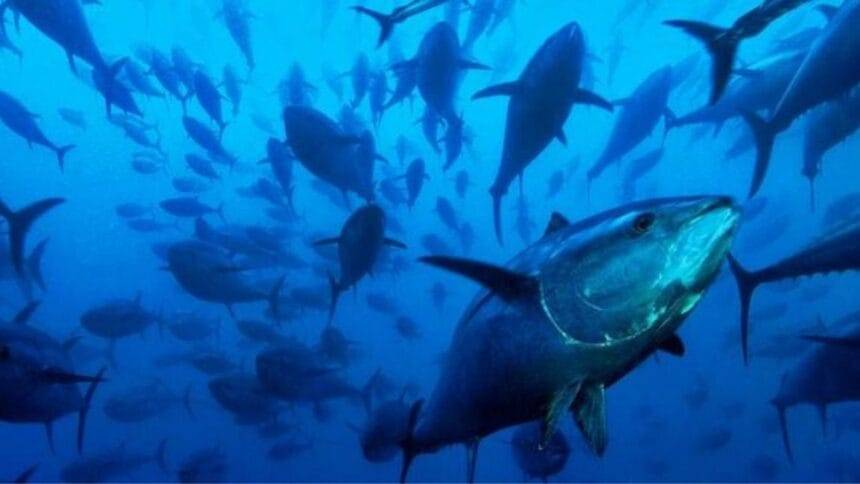Main Points In Hindi (मुख्य बातें – हिंदी में)
यहां प्रadhan mantri machli sampada yojana (PMMSY) के तहत मछुआरों के लिए मंत्रालय द्वारा किए जा रहे प्रयासों के मुख्य बिंदु दिए गए हैं:
-
मछुआरों के जीवन में सुधार: PMMSY योजना के अंतर्गत मत्स्य उत्पादन और निर्यात को बढ़ावा देने के साथ-साथ मछुआरों के जीवन स्तर में सुधार करने का लक्ष्य रखा गया है।
-
अंडमान और निकोबार द्वीपसमूह को टुना क्लस्टर के रूप में नामित करना: इस योजना के तहत अंडमान और निकोबार द्वीपों को टुना क्लस्टर के रूप में घोषित किया गया है, जो कि मछली पालन के विकास के लिए एक महत्वपूर्ण अवसर प्रदान करता है।
-
विशेष आर्थिक क्षेत्र का लाभ: अंडमान और निकोबार द्वीपों का विशेष आर्थिक क्षेत्र (EEZ) लगभग 6 लाख वर्ग किलोमीटर का है, जिसमें टुना और अन्य मूल्यवान प्रजातियों की भरपूर मात्रा है।
-
क्लस्टर विकास की व्यापक योजना: PMMSY योजना के अंतर्गत अन्य प्रमुख क्षेत्रों में क्लस्टर विकास किया जा रहा है, जिसमें मोती, समुद्री घास, सजावटी मछली पालन, और अन्य प्रकार की मछली खेती शामिल हैं।
- पोषण और स्वास्थ्य लाभ: टुना मछली खाने के स्वास्थ्य लाभ बताए गए हैं, जैसे हड्डियों को मजबूत करना, हृदय स्वास्थ्य में सुधार, वजन कम करने में सहायता, और रोग प्रतिरोधक क्षमता को बढ़ाना।
Main Points In English(मुख्य बातें – अंग्रेज़ी में)
Here are the main points from the provided text:


-
Pradhan Mantri Machli Sampada Yojana (PMMSY): The Ministry of Fisheries, Animal Husbandry, and Dairying is implementing PMMSY, a significant scheme aimed at enhancing fish production and export while improving the livelihoods of fishermen.
-
Tuna Cluster in Andaman and Nicobar Islands: The Fisheries Department has designated the Andaman and Nicobar Islands as a Tuna Cluster, leveraging its Special Economic Zone (EEZ) that spans approximately 6 lakh square kilometers, rich in tuna and other high-value fish species.
-
Cluster Development Projects: The scheme includes various fishery-related projects beyond tuna, such as pearl farming, seaweed production, cold water fish farming, and aquaculture, with potential cluster areas identified based on specific regional needs and current fishery infrastructure.
-
Tuna Resource Potential: India’s deep sea is estimated to contain about two lakh tonnes of tuna fish, with two main types: yellowfin and skipjack. However, only a fraction (25 thousand tonnes) is being caught due to pricing issues and post-catch spoilage.
- Health Benefits of Tuna: Tuna fish is highly regarded for its nutritional benefits, including high levels of omega-3 fatty acids, calcium, vitamin D, and magnesium, contributing to heart health, bone strength, eye health, and enhanced immunity.
Complete News In Hindi(पूरी खबर – हिंदी में)
मछली पालन, पशुपालन और डेयरी मंत्रालय प्रधानमंत्री मछली संपदा योजना (PMMSY) के तहत मछुआरों के लिए एक बड़ा कार्यक्रम चला रहा है। इस योजना का उद्देश्य न केवल मछली उत्पादन और निर्यात को बढ़ावा देना है, बल्कि मछुआरों के जीवन को बेहतर बनाना भी है। यह योजना क्लस्टर विकास पर आधारित है। इसके तहत, मत्स्य विभाग ने अंडमान और निकोबार द्वीप समूह को ट्यूना क्लस्टर के रूप में नामित किया है। मत्स्य विशेषज्ञों के अनुसार, अंडमान और निकोबार द्वीप समूह मछली पालन के विकास के लिए एक महत्वपूर्ण अवसर प्रदान करते हैं। यहां लगभग 6 लाख वर्ग किलोमीटर का विशेष आर्थिक क्षेत्र (EEZ) है।
यह क्षेत्र विशेष रूप से ट्यूना और अन्य उच्च मूल्य वाली प्रजातियों से भरा है। एकestima के अनुसार, यहां लगभग 60 हजार मीट्रिक टन ट्यूना मछली है। इस क्षेत्र की निकटता से दक्षिण-पूर्व एशियाई देशों के चलते समुद्री और हवाई व्यापार के अवसर मजबूत होते हैं। अंडमान और निकोबार द्वीप समूह को ट्यूना क्लस्टर के रूप में अधिसूचित करने से अर्थव्यवस्था को बढ़ावा मिलने, आय में वृद्धि और देशभर में मछली पालन के संगठित विकास को तेज करने की उम्मीद है।
PMMSY के क्लस्टर योजना में ये भी शामिल हैं
मत्स्य विभाग अन्य महत्वपूर्ण क्षेत्रों में भी क्लस्टर विकास पर काम कर रहा है। इसमें मोती, समुद्री काई और सजावटी मछली पालन, जलाशय मछली पालन, मछली पकड़ने के बंदरगाह, खारे पानी की एक्वाकल्चर, ठंडे पानी की मछली पालन, समुद्री बाड़ा संस्कृति, मीठे और खारे पानी की मछली पालन, गहरे समुद्र और महासागर मछली पालन, जैविक मछली पालन, दलदली मछली पालन और अन्य क्षेत्रों को शामिल किया जा रहा है। संभावित क्लस्टर स्थानों की पहचान राज्य सरकारों और केंद्र शासित प्रदेशों के साथ की जा रही है, जो मछली उत्पादन, उत्पादन प्रवृत्तियों, निर्यात आय, मछली पकड़ने वाली नावों की संख्या, मछली पालन गतिविधियों में भागीदारी और मौजूदा मछली पालन के बुनियादी ढांचे जैसे विशेष मानदंडों के आधार पर की जा रही है। मत्स्य विभाग ने पहले ही विकास के लिए तीन स्थानों को प्राथमिकता दी है।
भारतीय समुद्र ट्यूना मछली से भरा है
पिछले वर्ष, देश में मछली पालन क्षेत्र से संबंधित एक सम्मेलन का आयोजन किया गया। इस अवसर पर भारत और विदेशों से कई मछली पालन विशेषज्ञ शामिल हुए। इस दौरान जानकारी दी गई कि भारत का विशेष आर्थिक क्षेत्र (SEZ) ट्यूना मछली से भरा हुआ है। एक सर्वेक्षण के अनुसार, भारतीय गहरे समुद्र में लगभग दो लाख टन ट्यूना मछली है। हमारे देश में दो प्रकार की ट्यूना मछली पाई जाती है: एक येलोफिन और दूसरी स्किपजैक ट्यूना। लेकिन दुख की बात यह है कि दो लाख टन में से केवल 25 हजार टन ट्यूना मछली ही पकड़ी जा रही है। इसका एक कारण यह है कि अंतरराष्ट्रीय बाजार में इसे सही कीमत नहीं मिल रही है। मछली पालन विशेषज्ञों का कहना है कि मालदीव की ट्यूना मछली आठ डॉलर में बिकती है, जबकि भारतीय ट्यूना मछली के लिए कोई पूछता भी नहीं है। इसका कारण यह है कि गहरे समुद्र से ट्यूना मछली को पकड़कर वापस आने में छह से सात दिन लगते हैं, जिससे मछली खराब हो जाती है। यदि मछली पकड़ने वाली नाव में ठंडी भंडारण की सुविधा हो, तो भारतीय मछुआरे भी अंतरराष्ट्रीय बाजार में अच्छे दाम पा सकते हैं।
ट्यूना मछली क्यों पसंद की जाती है
मछली विशेषज्ञों का कहना है कि ट्यूना मछली खाने के कई फायदे हैं। चिकित्सक भी हड्डियों की बीमारी के मामले में इसे खाने की सलाह देते हैं, क्योंकि इसमें कैल्शियम, विटामिन डी और मैग्नीशियम अच्छी मात्रा में पाए जाते हैं। इसलिए ट्यूना खाना हड्डियों को मजबूत बनाता है। ट्यूना में ओमेगा-3 फैटी एसिड की मात्रा दिल को मजबूत बनाने के लिए जानी जाती है। ट्यूना मछली आंखों के स्वास्थ्य के लिए भी लाभकारी होती है और वजन कम करने में मदद करती है। कोविड-19 के दौरान यह पता चला कि ट्यूना मछली खाने से इम्यूनिटी बहुत तेजी से बढ़ती है।
Complete News In English(पूरी खबर – अंग्रेज़ी में)
The Ministry of Fisheries, Animal Husbandry and Dairying is working on a big scheme for fishermen under the Pradhan Mantri Machli Sampada Yojana (PMMSY). While this scheme will promote fish production and export, it will also improve the lives of fishermen. This scheme is cluster development. Under this, the Fisheries Department has declared Andaman and Nicobar Islands as Tuna Cluster. According to fisheries experts, Andaman and Nicobar Islands provide a major opportunity for fisheries development. There is a special economic zone (EEZ) of about 6 lakh square kilometers.
This area is especially rich in tuna and high value species like tuna. According to an estimate, there are about 60 thousand metric tons of tuna fish here. The proximity of Southeast Asian countries from here strengthens the opportunities for maritime and air business. The notification of Andaman and Nicobar Islands as Tuna Cluster is expected to accelerate the economy, increase income and organized development of fisheries across the country.
Also read: Be it Sunday or Monday, eat eggs every day…today is the birthday of the person who gave this slogan.
These are also included in the cluster scheme of PMMSY
The Fisheries Department is also working on cluster development in other key areas. This includes pearl, seaweed and ornamental fish farming, reservoir fish farming, fishing ports, brackish water aquaculture, cold water fish farming, sea cage culture, fresh water and brackish water fish farming, deep sea and ocean fish. Aquaculture, organic fish farming, wetland fish farming, and other areas as per specific regional and regional needs are also being included. Potential cluster locations are being identified with the State Governments and Union Territories based on certain parameters such as fish production, production trends, export earnings, number of fishing boats, participation in fish farming activities and existing fish farming infrastructure facilities. Is. The Fisheries Department has already identified three locations as priority areas for development.
Indian sea is full of tuna fish
Last year, a conclave related to the fisheries sector was organized in the country. On this occasion, dozens of fisheries experts from India and abroad participated. During this time, information was given that India’s Special Economic Zone (SEZ) is full of tuna fish. According to a survey, there are about two lakh tonnes of tuna fish in the deep sea of India. Two types of tuna fish are found in our country. One is yellowfin and the other is skipjack tuna. But sadly, out of two lakh tonnes, only 25 thousand tonnes of tuna fish is being caught. One reason for this is that it is not getting the right price in the international market. Fisheries experts say that tuna fish from Maldives is sold for eight dollars. Whereas no one even asks about Indian tuna fish. The reason for this is that it takes six to seven days to return tuna after catching it from the deep sea. In such circumstances the fish starts spoiling. If the fishing boat itself has the facility of cold storage, then Indian fishermen can also get good prices in the international market.
Also read: Azolla Explainer: Eating Azolla not only increases milk but also increases the lifespan of animals, it is also beneficial for chickens.
That’s why tuna fish is liked so much
Fish experts say that there are many benefits of eating tuna fish. Those who can eat, even doctors advise them to eat in case of bone disease. This is because calcium, vitamin D and magnesium are found in good quantities in tuna. Therefore eating tuna strengthens bones. The amount of Omega-3 fatty acids present in tuna strengthens the heart. Tuna fish is said to be beneficial for keeping eyes healthy and also for weight loss. During Covid-19, it was revealed that eating tuna fish increases immunity very rapidly.










